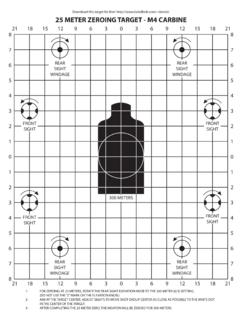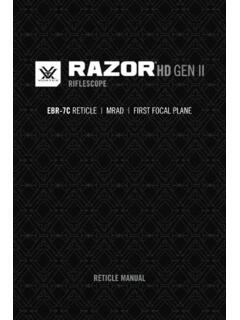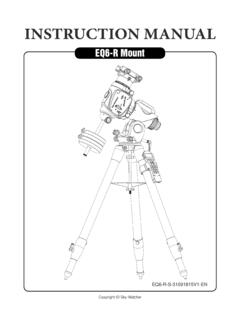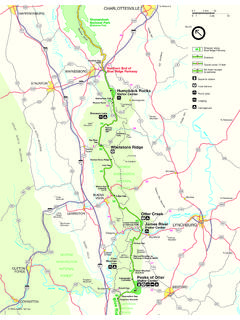Transcription of M249 Light Machine Gun in the Automatic Rifle Role
1 FM 23-14 Table Of ContentsRDLH omepageDocumentInformationDownloadInstru ctions*FM 23-14 HEADQUARTERSDEPARTMENT OF THE ARMYW ashington, DC, 26 January 1994FM 23-14M249 Light Machine GUN IN THE Automatic Rifle ROLETABLE OF CONTENTS I. PREFACEII. CHAPTER 1 DESCRIPTION AND COMPONENTSA. 1-1. DESCRIPTIONB. 1-2. (1 of 6) [1/11/2002 11:09:48 AM]FM 23-14 Table Of ContentsC. 1-3. AMMUNITIOND. 1-4. BLANK FIRING ATTACHMENTIII. CHAPTER 2 MAINTENANCEA. 2-1. CLEARING PROCEDURESB. 2-2. GENERAL DISASSEMBLYC. 2-3. INSPECTIOND. 2-4. CLEANING, LUBRICATION, AND PREVENTIVE MAINTENANCEE.
2 2-5. GENERAL ASSEMBLYF. 2-6. FUNCTION CHECKG. 2-7. MAINTENANCE PROCEDURESH. 2-8. MAINTENANCE DURING NBC CONDITIONSIV. CHAPTER 3 OPERATION AND FUNCTIONA. 3-1. OPERATIONB. 3-2. LOADINGC. 3-3. UNLOADINGD. 3-4. CYCLE OF FUNCTIONINGE. 3-5. SIGHT SETTINGS AND CORRECTIONSF. 3-6. BIPOD POSITIONINGV. CHAPTER 4 PROBLEMS AND DESTRUCTIONA. 4-1. MALFUNCTIONSB. 4-2. STOPPAGESC. 4-3. IMMEDIATE ACTIOND. 4-4. REMEDIAL ACTIONE. 4-5. DESTRUCTION PROCEDURESVI. CHAPTER 5 MARKSMANSHIP (2 of 6) [1/11/2002 11:09:48 AM]FM 23-14 Table Of ContentsSection I. INTRODUCTION TO MARKSMANSHIPA.
3 5-1. OBJECTIVESB. 5-2. TRAINING PHASESC. 5-3. TRAINING STRATEGYD. 5-4. TRAINING FOR COMBAT CONDITIONSS ection II. PRELIMINARY MARKSMANSHIP TRAININGA. 5-5. FUNDAMENTALS, MARKSMANSHIPB. 5-6. FUNDAMENTALS, FIRING POSITIONSC. 5-7. FUNDAMENTALS, NIGHT FIRINGD. 5-8. FUNDAMENTALS: NUCLEAR, BIOLOGICAL, AND CHEMICALE. 5-9. FUNDAMENTALS, MOVING TARGETSF. 5-10. FUNDAMENTALS, TRAVERSE AND SEARCHG. 5-11. DIRECT LAYH. 5-12. APPLICATION OF FIREI. 5-13. ADJUSTMENT OF FIREJ. 5-14. EFFECTS OF WINDK. 5-15. FIRE COMMANDSL. 5-16. DRY-FIRE EXERCISESM. 5-17. MULTIPURPOSE Machine GUN RANGE LAYOUTN.
4 5-18. BASIC Machine GUN TARGETO. 5-19. TARGET ANALYSISP. 5-20. 10-METER SCORING PROCEDURESS ection III. BASIC MARKSMANSHIP, LIVE-FIRE EXERCISESA. 5-21. ZEROINGB. 5-22. FIELD ZEROINGC. 5-23. 10-METER FIRINGD. 5-24. 10-METER CONDUCT OF FIREE. 5-25. 10-METER FIRING, QUALIFICATIONF. 5-26. TRANSITION (3 of 6) [1/11/2002 11:09:48 AM]FM 23-14 Table Of ContentsG. 5-27. TRANSITION CONDUCT OF FIREH. 5-28. TRANSITION FIRING, LIMITED VISIBILITYI. 5-29. ZEROING THE AN/PVS-4J. 5-30. QUALIFICATION STANDARDSVII. CHAPTER 6 COMBAT TECHNIQUES OF FIRES ection I. INTRODUCTIONA.
5 6-1. CHARACTERISTICS OF FIREB. 6-2. CLASSES OF FIRES ection II. APPLICATION OF FIREA. 6-3. TYPES OF TARGETSB. 6-4. DISTRIBUTION, CONCENTRATION, AND RATE OF FIREC. 6-5. TARGET ENGAGEMENTD. 6-6. TARGET ENGAGEMENT DURING LIMITED VISIBILITYS ection III. PREDETERMINED FIRESA. 6-7. TERMINOLOGYB. 6-8. RANGE CARDS ection IV. FIRE CONTROLA. 6-9. METHODS OF FIRE CONTROLB. 6-10. FIRE COMMANDSS ection V. RANGE (4 of 6) [1/11/2002 11:09:48 AM]FM 23-14 Table Of ContentsA. 6-11. RANGE ESTIMATIONB. 6-12. LATERAL DISTANCE MEASUREMENTS ection VI. ADVANCED Automatic Rifle MARKSMANSHIPA.
6 6-13. FIELD FIRING EXERCISEB. 6-14. ALTERNATE FIRING POSITIONSC. 6-15. MOVEMENT, SPEED, AND ALIGNMENTD. 6-16. RELOADINGE. 6-17. ALTERNATE FIRING POSITION EXERCISESVIII. CHAPTER 7 TRAIN-THE-TRAINER PROGRAMS ection I. ORGANIZATIONA. 7-1. OBJECTIVESB. 7-2. MISSION-ESSENTIAL TASK LISTC. 7-3. TRAINER ASSESSMENTD. 7-4. CADRE COACHESE. 7-5. COMMAND BENEFITSF. 7-6. PROGRAM PHASESS ection II. TRAINING TASKSA. 7-7. PHASE I, PRELIMINARY MARKSMANSHIP TRAININGB. 7-8. PHASE II, BASIC MARKSMANSHIP TRAININGC. 7-9. PHASE III, ADVANCED MARKSMANSHIP TRAININGS ection III.
7 TRAINER CERTIFICATION PROGRAMA. 7-10. TRAINING BASEB. 7-11. CERTIFICATION PROGRAM (5 of 6) [1/11/2002 11:09:48 AM]FM 23-14 Table Of ContentsIX. APPENDIX A UNIT TRAINING PROGRAMX. APPENDIX B PROFICIENCY (PERFORMANCE) EXAMINATIONXI. APPENDIX C M249 Automatic Rifle IN AIR DEFENSEXII. APPENDIX D RANGE SAFETYXIII. APPENDIX E EMPLOYMENTXIV. GLOSSARYXV. REFERENCESXVI. AUTHORIZATION (6 of 6) [1/11/2002 11:09:48 AM]FM 23-14 PREFACERDLH omepageTable ofContentsDocumentInformationDownloadIns tructionsPREFACEThis manual provides technical information, training techniques, and guidance on the M249 Light Machine gun in the Automatic Rifle role, which was formerly known as the squad Automatic weapon (SAW).
8 Since this manual addresses the M249's use in the Automatic Rifle role as opposed to the Light Machine gun role, it is referred to in this manual as the M249 AR. Unit leaders and the designated Automatic riflemen will find this information invaluable in their efforts to successfully integrate this Automatic weapon into their combat operations. The tactical positions shown in this manual may not be tactically correct, but they were drawn to enhance the reader's understanding of related subject material. Unless this publication states otherwise, masculine nouns and pronouns do not refer exclusively to men.
9 The proponent of this publication is the United States Army Infantry School. Send comments and recommendations on DA Form 2028 directly to Commandant, US Army Infantry School, ATTN: ATSH-IN-S3, Fort Benning, GA 31905-5596. DISTRIBUTION RESTRICTION: Approved for public release; distribution is unlimited. *This publication supersedes FM 23-14, 10 December 1985; and rescinds DA Form 5503-R, December 1985. [1/11/2002 11:10:42 AM]FM 23-14 Chapter 1 Description And ComponentsRDLH omepageTable ofContentsDocumentInformationDownloadIns tructionsCHAPTER 1 DESCRIPTION AND COMPONENTSThis chapter describes the weapon and the types of ammunition in detailand provides a table of general DESCRIPTIONThe M249 AR is a gas-operated, air-cooled, belt-and magazine-fed, Automatic weapon that fires from the open-bolt position ( Figure 1-1).
10 It has a maximum rate of fire of 850 rounds per minute. Primarily, ammunition is fed into the weapon from a 200-round ammunition box containing a disintegrating metallic split-link belt. As an emergency means of feeding, the M249 AR can use a 20- or 30-round M16 Rifle magazine, but this will increase the chance of stoppages. Although the M249 AR is primarily used as an Automatic Rifle , it is also used as a Light Machine gun. It can be fired from the shoulder, hip, or underarm position; or from the bipod-steadied position. When employed as a Machine gun, it has a tripod with a T&E mechanism and a spare barrel; however, barrels must not be interchanged with those from other M249s unless the headspace has been set for that weapon by direct support personnel.







